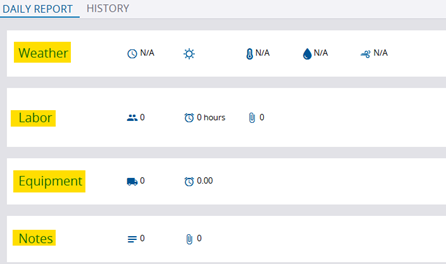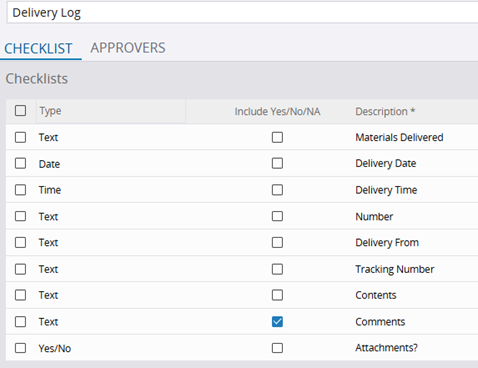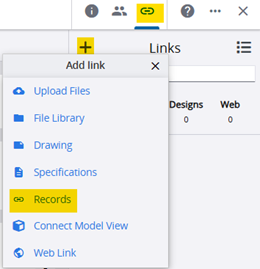Tip Tuesday
Checklists to Supplement Other Records in ProjectSight
How to utilize the Checklists feature in ProjectSight to provide more context for your other modules.
.png)
Trimble’s premiere project management software, ProjectSight, arrives to users equipped with standard – or “out of the box” – tools and interfaces designed to empower clients’ construction management needs. These preconfigured settings are highly editable, providing users with the means to alter nomenclature, dropdown lists and widget board views (to name a few) if ProjectSight’s original configuration does not align with the goals of those users.
A powerful tool in ProjectSight’s arsenal is the Checklists module. Meant to provide users with a means for creating templates and tracking checklists for active projects, this module can be used in a variety of contexts, including our topic today: supplemental information. In this hypothetical example, we will utilize the Checklists module to add a piece of auxiliary data to an already existing record like a Daily Report. In its preconfigured form, the software is already equipped with means to track weather, labor, equipment, and supplemental notes for each daily entry. For many users, this is the only information necessary for the successful completion of a Daily Report/Log.

Some users, though, may want to add supplemental information to each report. They could utilize the Portfolio Settings < Daily Reports < Custom Fields track to add a custom field cell to the “Additional Info” section of the Daily Reports module, but what if they want to enter multiple logs to the report or restrict report users to date or time fields? To accomplish our hypothetical goal of adding key supplemental information to a daily report, we will need to use the Checklists module.
A Brief Review of Checklists
First, we will conduct a quick refresh of how to create both a checklist and a checklist template. Unlike creating other entries like action items or contracts, checklists must be pulled from a template created in your project settings. To create a checklist template, you must follow Project Settings < Records < Checklists < Templates. Here we can fully customize the rows and columns for entering data in future checklist entries.
For our example, we will create a Delivery Log that we want to supplement data already found in the Daily Report. Below is an example of a configured Delivery Log in the Checklist Template:

Implementation of Checklist in Daily Report
Upon publishing the template, return to the Checklists module in the home page. When you click the “plus” icon, a dropdown for your recently completed template will appear and you can now populate that data. This is what the completed Delivery Log should look like:

Once I assign the status as “Approved”, I can tie that Delivery Log to a Daily Report. In the Daily Report module, click into the entry you wish to add the Delivery Log. Click the “Links” button in the top right corner, select the “plus” icon, and add your Delivery Log entry.

When you have successfully linked the checklist to the daily report, you will see it appear as an entry in your links section on the righthand side of your screen:

Whether I am a project manager or a field worker, if I have the proper security permissions I can view this supplemental Delivery Log within this Daily Report whenever I choose by clicking the record entry in the Links section.
ProjectSight comes preconfigured with several modules critical to client’s project and construction management needs. Those same modules, though wide in scope and packed with various functions, do not fit every user’s need perfectly. They may require supplemental information not available in the current configuration of a module. With the help of the Checklist module and the Checklist Template in the Project Settings, users can personally configure their ProjectSight experience to fit their and their team’s needs. If you have any questions regarding ProjectSight's features or are interested in adding this software to your company's project management repertoire, please visit our website - ConstrucTech Consulting - and Book a Call with one of our consultants.
Trimble’s premiere project management software, ProjectSight, arrives to users equipped with standard – or “out of the box” – tools and interfaces designed to empower clients’ construction management needs. These preconfigured settings are highly editable, providing users with the means to alter nomenclature, dropdown lists and widget board views (to name a few) if ProjectSight’s original configuration does not align with the goals of those users.
A powerful tool in ProjectSight’s arsenal is the Checklists module. Meant to provide users with a means for creating templates and tracking checklists for active projects, this module can be used in a variety of contexts, including our topic today: supplemental information. In this hypothetical example, we will utilize the Checklists module to add a piece of auxiliary data to an already existing record like a Daily Report. In its preconfigured form, the software is already equipped with means to track weather, labor, equipment, and supplemental notes for each daily entry. For many users, this is the only information necessary for the successful completion of a Daily Report/Log.

Some users, though, may want to add supplemental information to each report. They could utilize the Portfolio Settings < Daily Reports < Custom Fields track to add a custom field cell to the “Additional Info” section of the Daily Reports module, but what if they want to enter multiple logs to the report or restrict report users to date or time fields? To accomplish our hypothetical goal of adding key supplemental information to a daily report, we will need to use the Checklists module.
A Brief Review of Checklists
First, we will conduct a quick refresh of how to create both a checklist and a checklist template. Unlike creating other entries like action items or contracts, checklists must be pulled from a template created in your project settings. To create a checklist template, you must follow Project Settings < Records < Checklists < Templates. Here we can fully customize the rows and columns for entering data in future checklist entries.
For our example, we will create a Delivery Log that we want to supplement data already found in the Daily Report. Below is an example of a configured Delivery Log in the Checklist Template:

Implementation of Checklist in Daily Report
Upon publishing the template, return to the Checklists module in the home page. When you click the “plus” icon, a dropdown for your recently completed template will appear and you can now populate that data. This is what the completed Delivery Log should look like:

Once I assign the status as “Approved”, I can tie that Delivery Log to a Daily Report. In the Daily Report module, click into the entry you wish to add the Delivery Log. Click the “Links” button in the top right corner, select the “plus” icon, and add your Delivery Log entry.

When you have successfully linked the checklist to the daily report, you will see it appear as an entry in your links section on the righthand side of your screen:

Whether I am a project manager or a field worker, if I have the proper security permissions I can view this supplemental Delivery Log within this Daily Report whenever I choose by clicking the record entry in the Links section.
ProjectSight comes preconfigured with several modules critical to client’s project and construction management needs. Those same modules, though wide in scope and packed with various functions, do not fit every user’s need perfectly. They may require supplemental information not available in the current configuration of a module. With the help of the Checklist module and the Checklist Template in the Project Settings, users can personally configure their ProjectSight experience to fit their and their team’s needs. If you have any questions regarding ProjectSight's features or are interested in adding this software to your company's project management repertoire, please visit our website - ConstrucTech Consulting - and Book a Call with one of our consultants.
Trimble’s premiere project management software, ProjectSight, arrives to users equipped with standard – or “out of the box” – tools and interfaces designed to empower clients’ construction management needs. These preconfigured settings are highly editable, providing users with the means to alter nomenclature, dropdown lists and widget board views (to name a few) if ProjectSight’s original configuration does not align with the goals of those users.
A powerful tool in ProjectSight’s arsenal is the Checklists module. Meant to provide users with a means for creating templates and tracking checklists for active projects, this module can be used in a variety of contexts, including our topic today: supplemental information. In this hypothetical example, we will utilize the Checklists module to add a piece of auxiliary data to an already existing record like a Daily Report. In its preconfigured form, the software is already equipped with means to track weather, labor, equipment, and supplemental notes for each daily entry. For many users, this is the only information necessary for the successful completion of a Daily Report/Log.

Some users, though, may want to add supplemental information to each report. They could utilize the Portfolio Settings < Daily Reports < Custom Fields track to add a custom field cell to the “Additional Info” section of the Daily Reports module, but what if they want to enter multiple logs to the report or restrict report users to date or time fields? To accomplish our hypothetical goal of adding key supplemental information to a daily report, we will need to use the Checklists module.
A Brief Review of Checklists
First, we will conduct a quick refresh of how to create both a checklist and a checklist template. Unlike creating other entries like action items or contracts, checklists must be pulled from a template created in your project settings. To create a checklist template, you must follow Project Settings < Records < Checklists < Templates. Here we can fully customize the rows and columns for entering data in future checklist entries.
For our example, we will create a Delivery Log that we want to supplement data already found in the Daily Report. Below is an example of a configured Delivery Log in the Checklist Template:

Implementation of Checklist in Daily Report
Upon publishing the template, return to the Checklists module in the home page. When you click the “plus” icon, a dropdown for your recently completed template will appear and you can now populate that data. This is what the completed Delivery Log should look like:

Once I assign the status as “Approved”, I can tie that Delivery Log to a Daily Report. In the Daily Report module, click into the entry you wish to add the Delivery Log. Click the “Links” button in the top right corner, select the “plus” icon, and add your Delivery Log entry.

When you have successfully linked the checklist to the daily report, you will see it appear as an entry in your links section on the righthand side of your screen:

Whether I am a project manager or a field worker, if I have the proper security permissions I can view this supplemental Delivery Log within this Daily Report whenever I choose by clicking the record entry in the Links section.
ProjectSight comes preconfigured with several modules critical to client’s project and construction management needs. Those same modules, though wide in scope and packed with various functions, do not fit every user’s need perfectly. They may require supplemental information not available in the current configuration of a module. With the help of the Checklist module and the Checklist Template in the Project Settings, users can personally configure their ProjectSight experience to fit their and their team’s needs. If you have any questions regarding ProjectSight's features or are interested in adding this software to your company's project management repertoire, please visit our website - ConstrucTech Consulting - and Book a Call with one of our consultants.




